- Wilson, R. W., O'Mahony, N., Packham, C., Azzaro, M., 1999, "The seeing at the William Herschel Telescope", MNRAS, 309, 379. ADS
- Packham, C., O'Mahony, N., Wilson, R. W., 1998, "Recent developments in the Half Arcsecond Programme", New AR, 42, 431. ADS
- Azzaro, M., Breare, M., 1998, "Some meteorological parameters affecting the image quality of the WHT on La Palma", New AR, 42, 471. ADS
- O'Mahony, N., Packham, C., Wilson, R. W., Rutten, R., 1997, "Characterisation and Optimisation of Seeing at ING Telescopes", 23rd IAU General Assembly, Kyoto.
| THE ING NEWSLETTER | No. 2, March 2000 |
|
|
SCIENCE |
|
|
|
| Previous: | First Sodium Laser Beacon at La Palma | Up: | Table of Contents | Next: | WHT Millenium Upgrade |
Other available formats: PDF | gzipped Postscript
The Half Arcsecond Programme (I)
C. Packham1, R. W. Wilson2, M. Azzaro1, N. O'Mahony1, S. Fine1, D. Gray1, V. Reyes1, C. Martín1
1:
Isaac Newton Group
2:
ATC, Astrophysics Group, Cavendish Laboratory (soon to join the astronomical
instrumentation group at Durham)
Over the last three years, the Half Arcsecond Program (HAP) has found some important and surprising results. These results, recently published in the MNRAS (Wilson et al., 1999, 309, 379), are summarised on the HAP WWW site (http://www.ing.iac.es/Astronomy/development/hap/haphomepage.htm) and a short summary of the key conclusions follows.
The HAP was started by the ING in 1993 in order to optimise the image quality of the WHT, especially in preparation for NAOMI, the natural guide star adaptive optics system due to be commissioned in mid-2000 (see ING Newsletter No. 1). The goal of the HAP is to eliminate non-atmospheric degradations of the WHT's image quality, so that the measured image width for the WHT will be as close as possible to the intrinsic (site) seeing value.
Two main sources of image degradation can be distinguished in addition to the atmospheric seeing: (1) imperfections of the telescope itself, including tracking and focus errors and other optical aberrations, and (2) turbulence effects such as convection at the primary mirror and mixing of air at different temperatures in the light path, collectively referred to as dome seeing or artificial seeing.
An Early Result
One of the first problems identified by the HAP was the presence of two plumes of turbulent warm air flowing into the optical light path above the primary mirror. These were clearly visible in defocused (pupil) images from the WHT. The plumes emanated from the supporting fork structure of the primary mirror, heated by oil warmed during its lubricating passage around the WHT structure. It was clear that the WHT image quality suffered from this turbulence and that an engineering solution was required to reduce the temperature differential between the fork structure and dome air. Hence in September 1996 an oil cooling plant was installed to reduce and track the temperature of the telescope bearing oil to within a fraction of a degree of the dome air temperature. Subsequent pupil images showed the turbulent air plumes were eliminated, and also that heating of the air in the dome was significantly reduced during both night and day.
A Targeted but Sensitive Approach
Having removed the obvious contribution to dome seeing, more sophisticated and quantitative seeing measurement techniques were required to search for more subtle effects. In order to reduce the seeing of the WHT to that of the site, it was first necessary to accurately determine the site seeing. In October 1994 a Differential Image Motion Monitor (DIMM) was installed on a tower near the WHT (see Figure 1). A DIMM measures the seeing via the differential motion of stellar images and hence is unaffected by wind shake, poor tracking, focus, etc. and therefore gives an unbiased estimate of the atmospheric seeing. In fact the DIMM measures the Fried parameter (r0) or spatial coherence length of starlight. For the standard (Kolmogorov) theory of atmospheric turbulence this is related to the seeing FWHM for a large telescope (in the absence of other aberrations) by:
where l is the wavelength
of observation. Hence the accuracy of the DIMM seeing estimates depends
on the validity of the standard seeing model at the site.
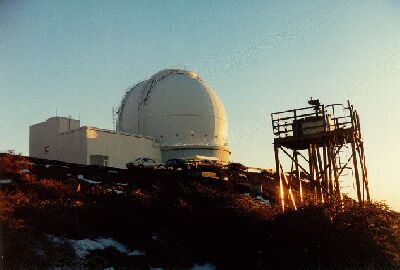 |
| Figure 1. The ING DIMM tower near the WHT. [ JPEG | TIFF ] |
The DIMM has been used by ING
to provide an extensive set of seeing data for the WHT site. The results
of the monitoring campaign between October 1994 to August 1998 are displayed
in Figure 2, which shows median site seeing at the WHT to be 0.69 arcseconds,
in good agreement with other surveys carried out at other sites on the
Roque by collaborators at the IAC.
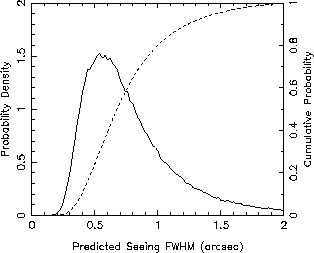 |
| Figure 2. DIMM seeing measurements. [ TIFF ] |
JOSE/DIMM Correlation
By collating JOSE and DIMM observations
to form an integrated data set, it is possible to compare statistics of
the seeing inside the WHT to the site seeing. In Figure 3 measured values
of r0 from DIMM observations (4500 measurementsa on
18 nights) and contemporaneous JOSE observations (2998 measurements) are
plotted. Clearly there is no significant offset in the distribution of
r0 between JOSE and DIMM.
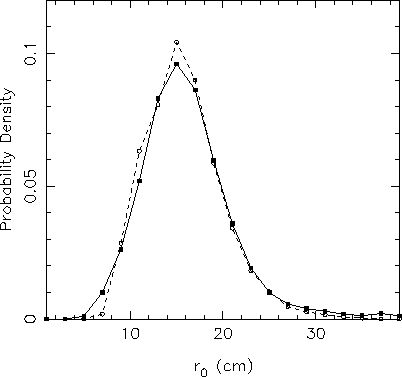 |
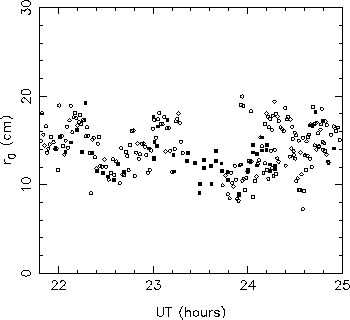 |
| Figure 3. Normalised probability distributions for contemporaneous JOSE (solid line) and DIMM (broken line) r0 measurements determined from measurements on 18 nights between 1995 May and 1998 August. [ TIFF ] | Figure 4. Example of contemporaneous JOSE (filled squares) and DIMM (open circles) r0 measurements. [ TIFF ] |
The JOSE wavefront sensor data allows the validity of the standard turbulence model for the WHT site to be examined. Figure 5 shows the mean (relative) distribution of rms Zernike mode strengths for the seeing-induced wavefront aberrations at the WHT focus. The data are plotted against their theoretical values for the Kolmogorov turbulence model (Noll, R. J., 1976, J Opt Soc Am, 66, 207). Clearly the measured distribution is close to theoretical expectation, so that the DIMM and JOSE seeing FWHM predictions are valid. In fact the data show evidence for an outer scale of turbulence (i.e. upper limit to the scale of the seeing aberrations) with a mean value of approximately 15 m. As a result the DIMM and JOSE predictions may somewhat over-estimate the WHT seeing at long wavelengths (R-band and longer), since equation 1 assumes an infinite outer scale.
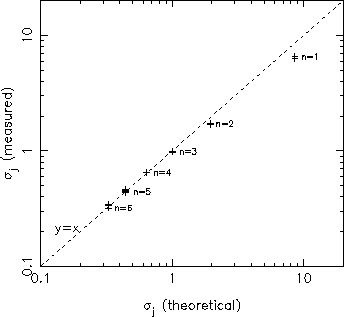 |
| Figure 5: Zernike Modelling of JOSE Data. [ TIFF ] |
Conclusions
It is important to consider why
the WHT does not appear to suffer from artificial seeing. It is generally
accepted that excess temperature of the mirror, dome or support gives rise
to artificial seeing. Figures 6 and 7 show the summation of several years
data obtained during observing nights for the dome minus external air temperature
and mirror minus dome temperature respectively. Figure 6 shows that
large dome temperature excesses are very rare. Calibration of the temperature
sensors has shown a drift in the external thermometer by ~1.5 K over the
several years of operation and hence in reality the 1 K offset suggested
by Figure 6 is even smaller. Large primary mirror temperature offsets are
more frequent, but the differential is >2 K for only ~25% of observing
time. We speculate that such a large offset occurs only during rapid weather
changes where the large thermal inertia of the (thick) primary mirror retains
excess thermal energy for one or two nights, but that the atmospheric seeing
will in that case be sub-optimal due to rapidly changing weather conditions.
It also seems that under normal circumstances, the considerable thermal
inertia and good insulation of both the primary mirror and dome air mass
prevent the mirror from absorbing significant heat from the air during
the daytime, leaving it close to the air temperature of the previous night.
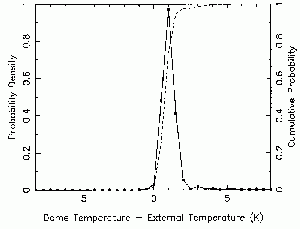 |
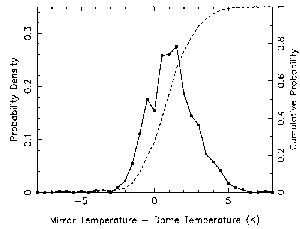 |
|
|
|
The fact that no significant artificial seeing in the WHT has been detected after cooling the WHT's oil is certainly against common perception of the WHT seeing. In part this is due to reliance on the WHT's autoguider for seeing information. The autoguider has an independent focus, optical aberrations and several other 'features', and so gives only an approximate (and certainly pessimistic) estimate of the true WHT seeing.
In the absence of dome seeing, the remaining tasks for the HAP at the WHT are to optimise the tracking and focus of the telescope. The power spectrum of image motion measured by the JOSE sensor reveals a spike due to the known oscillation of the WHT support structure at 2.7 Hz. Whilst this resonance contributes little power on average, the oscillation can have a significant effect on image width if it is strongly excited, for example by wind buffeting of the telescope structure. In future it may be possible to monitor the telescope drive encoders automatically, and to alert the observer to excess tracking errors at high frequencies. A significant contribution to the image FWHM at the WHT (as for all telescopes) may result from imperfect focus. Current methods for estimation of the optimum focus are limited by the inherent variability of the site seeing. Improved methods to focus and to track the focus of the WHT are under investigation.
In the next issue of the ING newsletter
we will discuss the HAP at the INT and the future of the HAP.
HAP Publications:
Email contact: Chris Packham (cp@ing.iac.es)
(a)
We wish to thank the IAC seeing group for providing some DIMM measurements
useful for our analysis.
| Previous: | First Sodium Laser Beacon at La Palma | Up: | Table of Contents | Next: | WHT Millenium Upgrade |
| GENERAL | SCIENCE | TELESCOPES AND INSTRUMENTATION | OTHER NEWS FROM ING | TELESCOPE TIME |